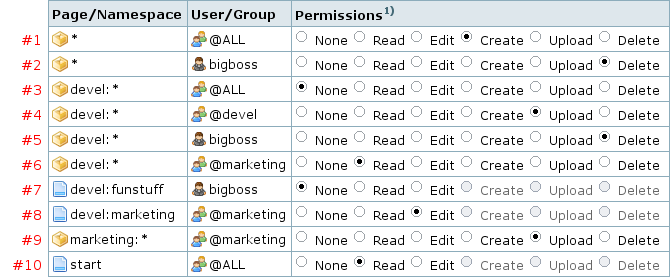访问控制列表 (ACL)
DokuWiki – 正如其他wiki — 默认是很开放的。 每个人都能创建、编辑、删除页面。 但是有时候对一些页面甚至所有页面作个限制也是合理的。 这时候我们就要用到 访问控制列表 (ACL) 了。 本页面将介绍怎么使用ACL和怎么配置它。

配置
ACL 可以在安装向导里被激活,同时会初始化一个 ACL 策略。如果要手动激活 ACL,打开 useacl 选项并把 conf/acl.auth.php.dist、conf/users.auth.php.dist 这两个文件重命名为 conf/acl.auth.php、conf/users.auth.php。
参见
还有一些额外的选项和特性与授权、用户注册以及 ACL 设置有关。请参考它们相应的维基页面来获取更多信息:
- 配置选项 useacl – 激活 ACL
- 配置选项 superuser – 设置拥有 ACL 授予权限的超级用户
- 配置选项 disableactions – 允许你禁用开放注册
- 配置选项 defaultgroup – 新用户的默认组
- 用户管理器 – 管理用户
- 认证后端 – 使用不同数据源来验证用户
访问限制
访问控制可以针对页面或者命名空间。共有7种权限:无、读取、编辑、创建、上传、删除以及管理。高权限会包含低权限,其中读取是最低的权限,删除是最高的权限。需要注意的是,创建、上传和删除权限只能应用于命名空间。
为命名空间设置的规则也会应用到其下的媒体文件和页面1)。
当 Dokuwiki 检查它应该给用户何种权限时,它会使用所有匹配该用户及其所在组的规则。最终应用的权限规则由以下方式选出:
在用户管理(或者验证后端)中,用户总是属于某个组。然而,有两个组 groups 有点特别:
- @ALL。每个人,即便是没有登录的人,都属于这个组。你可以使用这个组来限制所有人的访问权限(作为默认设置),然后再对特定用户放宽权限。
- @user。所有自主注册的用户,默认都属于这个组。用这个组来给予“已登入”用户权限。这个组的名字可以通过默认组选项配置。与虚拟的“ALL”组不同,“user”组是真实的组,是在使用简单身份验证后端时所有用户默认加入的组。如果你使用不同的验证后端,你需要使用这个后端所提供的组。
在内部以及 ACL 管理器中,组由“@”前缀和组名来表示。
编辑 ACL
想方便地添加新规则或更改已存在的规则,你需要使用“管理”菜单中的 ACL 管理器。关于它的更多描述可以在这里找到。
基本上,增加一条新的 ACL 规则有三个步骤:
- 从左上角的树状导航栏中选择需要限制的命名空间或者页面
- 选择需要应用 ACL 规则的组或人
- 从下拉框中选择已知组或用户
- 或者,选择“User:”或“Group:”,然后输入组名或用户名
- 设置适当的权限
已有规则可以在 ACL 管理器下面的表格中修改或者删除。
ACLs示例
在这个部分,我们举例说明访问规则是怎么工作的:
我们一行一行地看:
- 任何人都能创建并编辑页面,但是不能upload.
- 用户 bigboss 拥有所有权限。
- 此刻,devel这个namespace谁都不能动。
- 哦,看到这一行,我们发现事实不是这样,devel组(有个@标志的是组,没有的是人)是拥有完全权限的。
- 当然 bigboss 也被授权了 – 而且他是唯一一个有权删除upload文件的人.
- 然后,@marketing组能读devel这个namespace的所有内容,但是只能读。
- 然而,devel组里的兄弟们不想让 bigboss 读devel namespace中的 funstuff页面。这就是上面说的那个“specific matching”原则。
- 最后, marketing 组可以编辑
devel:marketing页。 - namespace
marketing也设置了. marketing 组的成员都被允许upload - 其他用户因为规则1的授权,能够创建、编辑,但是不能upload. bigboss 则因为规则2 的授权,他能upload 并 delete 文件. - 最后一行限制了主页(start 页面),任何人都只能读,不能改。(只有超级用户才能改)。
下面这个例子可以让你更好地理解 specific matching: (俺就不翻译了)
This time we look what rules will match for different users when trying to access the page private:bobspage.
- abby, a regular user
- three rules match, #1, #2, #4
- rule #4 is closest, it matches at the namespace level so it takes precedence over the other three
- abby's permissions level is 0
- bob, a regular user
- four rules match, #1, #2, #4, #6
- rule #6 wins as its an exact match
- bob's permission level is 16
- bob forgets to login and tries to access his page
- two rules match, #1 & #4
- rule #4 is closer, it wins
- bob's permission level while not logged in is 0
- charlie, a staff member
- five rules match, #1 - #5
- two rules match at namespace level, #5 gives charlie the higher permission so it wins
- charlie's permission level is 16
Note rule #5, which appears to duplicate rule #3. Without it, staff members wouldn't be able to access the private namespace as rule #4 would keep them out.
Background Info
这段是背景知识,告诉你ACL文件存在哪里,但是不建议你直接修改,所以俺不翻译了。
Access restrictions are saved in a file called conf/acl.auth.php, which should be writable by the webserver if you want to use the ACL admin interface described above. It is not recommended to edit this file manually. Use the admin interface instead.
Empty lines and shell-style comments are ignored. Each line contains 3 whitespace separated fields:
- A group or user name. Groupnames are marked by a leading
@character. - A permission level (see below).
There are 7 permission levels represented by an integer. Higher levels include lower ones. If you can edit you can read, too. However the admin permission of 255 can not be used in the conf/acl.auth.php file. It is only used internally by matching against the superuser option.
| Name | Level | applies to | Permission | DokuWiki constant |
|---|---|---|---|---|
| none | 0 | pages, namespaces | no permission – complete lock out | AUTH_NONE |
| read | 1 | pages, namespaces | read permission | AUTH_READ |
| edit | 2 | pages, namespaces | existing pages may be edited | AUTH_EDIT |
| create | 4 | namespaces | new pages can be created | AUTH_CREATE |
| upload | 8 | namespaces | mediafiles may be uploaded | AUTH_UPLOAD |
| delete | 16 | namespaces | mediafiles may be overwritten or deleted | AUTH_DELETE |
| admin | 255 | admin plugins | superuser4) can change admin settings | AUTH_ADMIN |
Here is an example setup matching the first example given above:
* @ALL 4 * bigboss 16 devel:* @ALL 0 devel:* @devel 8 devel:* bigboss 16 devel:* @marketing 1 devel:funstuff bigboss 0 devel:marketing @marketing 2 marketing:* @marketing 8 start @ALL 1
Please note, that order does not matter in the file. The file is parsed as whole, then a perfect match for the current page/user combo is searched for. When a match is found further matching is aborted. If no match is found, group permissions for the current page are checked. If no match is found the check continues in the next higher namespace.



User Wildcards
这段是说如果你的wiki有非常多的注册用户的话,你可以用通配符。 这段也不翻译了。
It is possible to use user wildcards in the ACLs. This can be useful for Wikis with many registered users, if you want to give each user a personal namespace where only he/she has write access, and you don't want to edit the ACLs for each user. To accomplish that %USER% is replaced by the username of the currently logged in user.
In the following example a logged in user gains full access (upload/delete) permissions for the user's namespace users:<username>:* and revoke all access from other namespaces located in users:*
In this case logged in user has access to own namespace only and have not access to users namespaces (even view names of namespaces) of other users.
# # Grant full access to logged in user's namespace users:%USER%:* %USER% AUTH_DELETE # # Allow to browse own namespace via INDEX users: %USER% AUTH_READ # # Allow read only access to start page located in <users> namespace users:start %USER% AUTH_READ # # Disable all access to user's home namespaces not owned by logged in user (include view namespaces via INDEX) users:* @user AUTH_NONE

conf/acl.auth.php) or correct them manually after each operations with ACL from GUI because mask %25USER%25 does not work as expected, only %USER% should be used in the conf/acl.auth.php.



